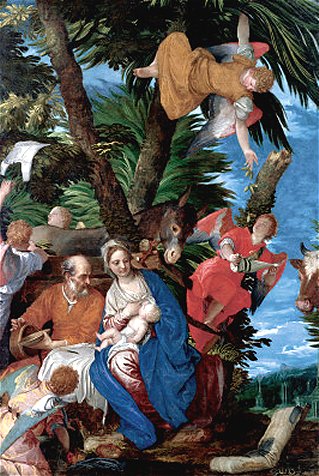He painted on canvas as well as magnificent frescos for villas in the surroundings of Venice and is considered to be one of the great painters of the 16 th century. His works were prophetic of the development of the 17th century and his influence on Annibale Carracci, Rubens, Van Dyke, Pietro da Cortona and in particular, Tiepolo, was significant. Subject: The bare statement given by Matthew was greatly amplified in various New Testament apocryphal texts which are the source of the themes found in art. The rest on the flight was a popular theme in the art of the Counter Reformation and was more often of a devotional than a narrative character. In it the Virgin and Child along with Joseph are seated in a landscape, their belongings lie on the ground and they are assisted by angels who serve food. A palm tree, emblematic of the Christian martyr is part of the scene. The Biblical account of the sojourn in Egypt is so brief that such an episode as the rest is not mentioned. The flight into Egypt was, in fact, the invention of Christian mythologists who were eager to expand on the few references to Jesus' early life. Painting: In this idyllic vision of the Holy Family at rest in the countryside, the Madonna, nursing her very human Christ child, anchors the composition while angels attending the Holy Family lend a festive and somewhat amusing air to the scene. They are shown gathering dates from the trees, curring the donkey and even doing the laundry. The humor of the scene is undercut, however, by the V shaped formation of branches over the Virgin's head which refers to Christ's crucifixtion. The composition of the painting is thought to be based on Titian's Death of St. Peter Martyr from which Veronese took the V shaped trees and from Durer's The Flight into Egypt which had a similar donkey and lush tropical setting. The canvas is joined on the center line of the painting and there are some some damages to be noted on the shoulders of Joseph and the Madonna. It was acquired by Ringling c.1925-26. Historical Context: His love of richness and ornament in his painting got him into trouble with the Inquisition, at one point , who took him to task for his painting of The Last Supper into which he had crowded "irrelevant and irreverent" figures. He argued against a change to the painting but it was subsequently renamed The Feast in the House of Levi. |
